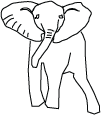Born on May 11, 1904, Salvador Dali he Domenech he would become one of the world’s most recognized surrealist artists. Raised by his lawyer/notary father and a mother who encouraged her artistic son, Dali grew up in Figueres, Catalonia, Spain, having been told by his parents that he was the reincarnation of his older brother, Salvador, who died just nine months before Dali’s birth.
Following the death of his mother to breast cancer in 1921, Dali moved to the student residences at the School of Fine Arts in Madrid. He spent several years studying there and then shortly before his graduation, he was expelled for declaring that no one on the faculty of the school was competent enough to examine him.
By 1931, Dali had collaborated on a short film with surrealist director Luis Bunuel; illustrated a book called “The Witches of Liers”, a poem written by his friend and classmate Carles Fages de Climent; met his muse and future wife Gala; and painted arguably his most famous work The Persistence of Memory. He had officially joined the surrealist group in Paris, and was hailed by the surrealist community of artists.
When Salvador Dali openly supported the regime of Francisco Franco following the Spanish Civil war, and showed interest in what he referred to as the “Hitler phenomenon”, he became somewhat of an outcast among his fellow artists. Many of his fellow surrealists referred to Dali in past tense, indicating their feeling that he was dead to them. He wrote prolifically during this time, and continued producing his art.
In 1940, Dali and Gala moved to the United States, and it was during this time that Dali reclaimed his Catholic faith. In 1942, Dali wrote his autobiography, “The Secret Life of Salvador Dali”. He asked an Italian monk to perform an exorcism on him in the late 1940’s, and in exchange for the exorcism, he presented the friar with a sculpture of Jesus Christ on the cross, which was not discovered until 2005. Although they had been married civilly in 1934, Dali and Gala were married in the Catholic Church in 1958.
In the late 1940’s, Dali and Gala returned to Spain. Dali continued a prolific career in art, being one of the first artists to use holography and taking great inspiration from his Catholic faith and the events of the day, including the bombing at Hiroshima. From this time period, two of Dali’s most famous works, Hallucinogenic Toreador and La Gare de Perpignan were created.
Dali’s work was used in advertising campaigns, most notably for Chupa Chups candy and Lanvin chocolates, and he became fascinated by DNA and the hypercube, which can be seen in some of his later work.
King Juan Carlos of Spain bestowed upon Dali the title Marquis of Pubol in 1982. By this time, Dali was seriously ill, having been given unprescribed medicine by his senile wife Gala. The medications damaged Dali’s nervous system and gave him Parkinson’s like tremors in his hands.
Gala died in 1982, leaving the stricken Dali devastated. He was brought back to Figueres in 1984 by friends who felt a deliberate dehydration of the artist and a fire in his bedroom were suicide attempts.
On January 23, 1989, Salvador Dali, known for his contributions not only to surrealism, but also to fashion, theatre, and photography, died from heart failure. He is buried in a crypt at his Teatro Museo de Figueres, just steps from his childhood home.
- ( http://www.surrealism.org/dali.html)






















